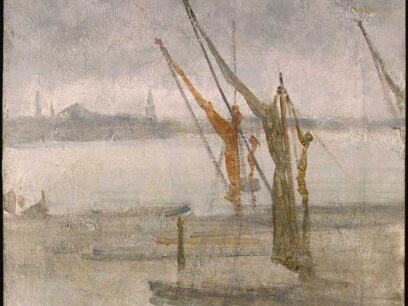May 2, 2010
Grey and Silver: Chelsea Wharf, c. 1864/1868

James McNeill Whistler
Widener Collection 1942.9.99
After working on Wapping in 1864, Whistler moved away from his earlier approach of painting outdoors. He began a practice of boating down the Thames river to observe London from a different perspective; he then returned to his studio to create landscapes from memory or from the sketches he made while boating. In Grey and Silver: Chelsea Wharf, the factories in the distance are blurred and blend together as if he imagined them there. A few dark lines and shapes create the masts on the docks. His color palette for this particular piece if one of muted tones and complementary blue, grey and orange colors. Whistler stated, "As music is the poetry of sound, so is painting the poetry of sight,” connecting the fluidity of music to the possibility of this color palette blending together to create this painting.
Whistler was often criticized for the high price at which he sold his paintings. In 1878 such comments provoked him to engage in an expensive lawsuit and when asked if his paintings created in two days were worth the large amounts he charged he replied, "No. I ask it for the knowledge of a lifetime." Like Grey and Silver: Chelsea Wharf, Whistler believed each painting to be a part of his lifetime of work, all equally as important and worth the same.
Preserving America’s Sailing Legacy
Engaging Sailing’s Next Generation
Stay Connected to the National Sailing Hall of Fame
